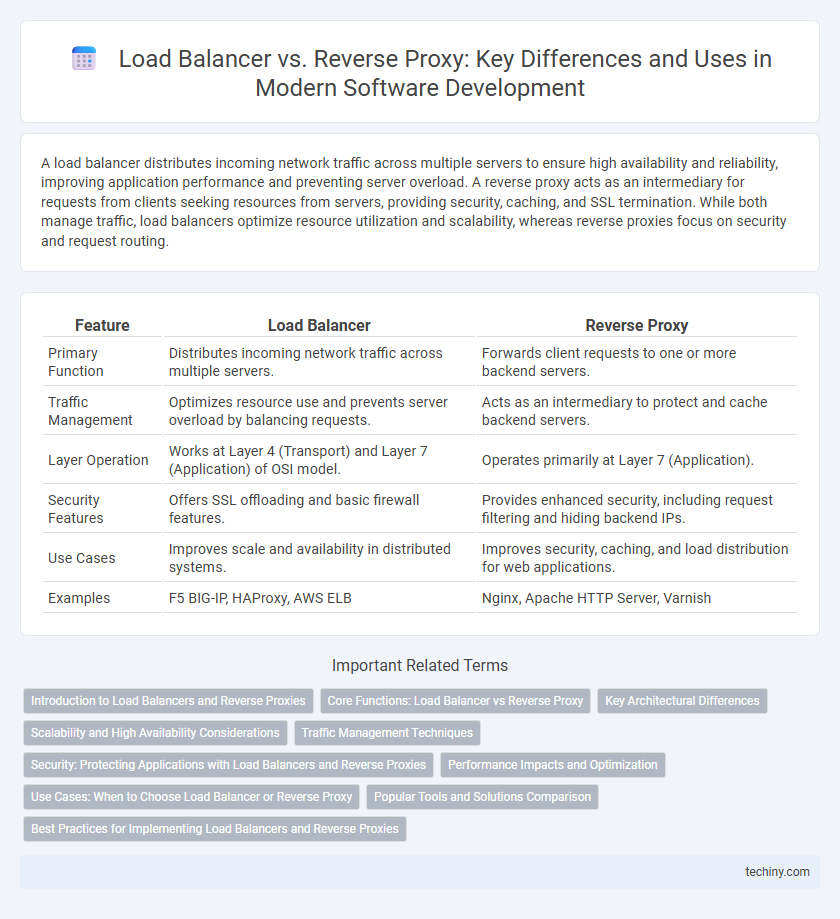A load balancer distributes incoming network traffic across multiple servers to ensure high availability and reliability, improving application performance and preventing server overload. A reverse proxy acts as an intermediary for requests from clients seeking resources from servers, providing security, caching, and SSL termination. While both manage traffic, load balancers optimize resource utilization and scalability, whereas reverse proxies focus on security and request routing.
Table of Comparison
| Feature | Load Balancer | Reverse Proxy |
|---|---|---|
| Primary Function | Distributes incoming network traffic across multiple servers. | Forwards client requests to one or more backend servers. |
| Traffic Management | Optimizes resource use and prevents server overload by balancing requests. | Acts as an intermediary to protect and cache backend servers. |
| Layer Operation | Works at Layer 4 (Transport) and Layer 7 (Application) of OSI model. | Operates primarily at Layer 7 (Application). |
| Security Features | Offers SSL offloading and basic firewall features. | Provides enhanced security, including request filtering and hiding backend IPs. |
| Use Cases | Improves scale and availability in distributed systems. | Improves security, caching, and load distribution for web applications. |
| Examples | F5 BIG-IP, HAProxy, AWS ELB | Nginx, Apache HTTP Server, Varnish |
Introduction to Load Balancers and Reverse Proxies
Load balancers distribute incoming network traffic across multiple servers to optimize resource use, maximize throughput, and ensure high availability in software applications. Reverse proxies act as intermediaries that receive client requests, forwarding them to backend servers while providing added security, caching, and SSL termination. Both components are essential in modern software development architectures for improving scalability and enhancing performance.
Core Functions: Load Balancer vs Reverse Proxy
Load balancers distribute incoming network traffic across multiple servers to ensure high availability and reliability, optimizing resource use and preventing any single server from becoming overwhelmed. Reverse proxies act as intermediaries between clients and servers, enhancing security by masking server details, caching content, and managing SSL encryption. Both improve system performance but serve distinct roles: load balancers focus on traffic distribution and fault tolerance, while reverse proxies emphasize security, caching, and request routing.
Key Architectural Differences
Load balancers distribute incoming network traffic across multiple servers to ensure high availability and reliability, while reverse proxies handle client requests by forwarding them to backend servers for additional functions such as caching, security, and request routing. Load balancers operate primarily at the transport layer (Layer 4) or application layer (Layer 7), focusing on optimizing resource use and preventing server overload. Reverse proxies work mainly at the application layer (Layer 7), offering enhanced control over client-server interactions through features like SSL termination, authentication, and content filtering.
Scalability and High Availability Considerations
Load balancers distribute incoming network traffic across multiple servers to ensure scalability and high availability by preventing any single server from becoming a bottleneck. Reverse proxies act as intermediaries, managing client requests and enhancing security while enabling load balancing functions for improved fault tolerance. Both technologies play critical roles in designing scalable and highly available software architectures by optimizing resource utilization and minimizing downtime.
Traffic Management Techniques
Load balancers distribute incoming network traffic across multiple servers to ensure reliability, scalability, and optimal resource utilization in software applications. Reverse proxies act as intermediaries that handle client requests, providing security, caching, and SSL termination while forwarding traffic to backend servers. Both traffic management techniques enhance system performance and availability but differ in their primary roles and operational layers within network architecture.
Security: Protecting Applications with Load Balancers and Reverse Proxies
Load balancers and reverse proxies enhance application security by distributing traffic and preventing overload, which mitigates denial-of-service attacks. Reverse proxies provide an additional security layer by masking backend server identities and filtering malicious requests through web application firewalls. Both technologies support SSL termination, reducing encryption overhead on servers and enabling centralized certificate management for secure communication.
Performance Impacts and Optimization
Load balancers distribute incoming network traffic evenly across multiple servers, enhancing scalability and preventing any single server from becoming a bottleneck, which directly improves application performance and uptime. Reverse proxies primarily manage client requests by caching content, SSL termination, and reducing server load, resulting in faster response times and optimized resource utilization. Both tools optimize performance by efficiently managing traffic but serve different roles; load balancers focus on workload distribution, while reverse proxies enhance security and accelerate content delivery.
Use Cases: When to Choose Load Balancer or Reverse Proxy
Load balancers are ideal for distributing incoming network traffic across multiple servers to enhance application scalability and reliability, especially in high-traffic environments like e-commerce platforms or cloud services. Reverse proxies excel in improving security, caching, and SSL termination, making them suitable for protecting backend servers, optimizing content delivery, and managing client requests in web applications. Organizations should choose load balancers for traffic distribution and fault tolerance, while reverse proxies are preferred for security enforcement and request routing.
Popular Tools and Solutions Comparison
Popular load balancer tools include HAProxy, NGINX, and AWS Elastic Load Balancing, known for distributing traffic efficiently across multiple servers to ensure high availability and reliability. Reverse proxy solutions such as NGINX, Apache Traffic Server, and Traefik specialize in securing and accelerating client requests by acting as an intermediary between users and backend servers. Comparing these popular tools reveals that NGINX uniquely functions as both a load balancer and a reverse proxy, offering versatile deployment options tailored to diverse software development environments.
Best Practices for Implementing Load Balancers and Reverse Proxies
Implementing load balancers and reverse proxies requires strategic placement and configuration to optimize traffic distribution and security across servers. Utilize health checks and session persistence to maintain application reliability and user experience, while ensuring SSL termination is managed efficiently to offload encryption overhead from backend servers. Employing role-specific tools such as NGINX for reverse proxying and HAProxy for load balancing can enhance scalability and fault tolerance in software development environments.
Load Balancer vs Reverse Proxy Infographic

 techiny.com
techiny.com